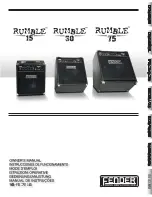
I-Tech HD DriveCore Series
Power Amplifiers
Operation Manual
page 63
Fig. 16.4 Magnitude (left) and phase (right) of a 3 kHz Linquitz-Riley
4
th
-order crossover filter.
Fig. 16.5 Measured individual driver responses (left) and overall
summed on-axis response (right) of a two-way system with a 4
th
-order
3 kHz LR crossover.
16 Application of FIR Filters to Loudspeaker Crossovers
The next two graphs in Fig. 16.5 show the measured individual driver
responses of the two-way system driven by the LR crossover as
produced by the Crown I-Tech HD amplifier and the resultant summed
1m on-axis response.
Note that the individual driver responses were first equalized using the
amplifier’s parametric equalizer to be more of less flat over a
significantly wide range above and below crossover. After the initial
equalization, the chosen crossover was applied and adjusted. Slight
delay was added to the tweeter channel to compensate for driver offset
to insure that the high- and low- pass sections were in phase
through crossover.
One unexpected benefit of the FIR crossover was the speed up of the
adjustments to insure that the drivers were in-phase through crossover.
This was because the linear/zero phase characteristic of the FIR filter
did not change the phase of the individual drivers when the crossover
was applied! The linear phase characteristic of the FIR-filter based
crossover significantly reduces the setup time of the crossover as
compared to an IIR implementation.
All measurements were accomplished using windowed freefield
techniques in a non-anechoic room at 1m using a 25 ms window. This
window size allows fairly-accurate measurements to be made down to
abut 100 Hz.
IIR Measurements
A 4th-order Linquitz-Riley (LR) crossover with 24 dB/octave slopes at
3 kHz was chosen to demonstrate a typical well-designed conventional
crossover. Although, in conventional terms, a relatively sharp 24 dB/
octave crossover slope is considered quite sharp. The crossover region
spans a relatively wide two octaves. This means that effectively both
woofer and tweeter are radiating simultaneously between roughly 1.5
and 6 kHz.
Level - dB
Frequency - Hz
20
-30
-20
-10
Low Pass
High Pass
0
10
100
1k
10k 20k
Level - dB
Frequency - Hz
20
-30
-20
-10
Woofer
Tweeter
0
10
100
1k
10k 20k
Level - dB
Frequency - Hz
20
-30
-20
-10
0
10
100
1k
10k 20k
Phase - Degs
Frequency - Hz
20
-180
-90
0
Low Pass
High Pass
90
180
100
1k
10k 20k
The following two graphs in Fig. 16.4 show the theoretical frequency
response magnitude (left) and phase (right) of a 3 kHz LR 4
th
-order
crossover. In each graph, individual curves are shown for the low pass
(blue) and high pass (red) portions of the crossover. Note that both
low-pass and high-pass filters are 6 dB down and in-phase at the 3 kHz
crossover and thus sum to unity. Note also that the phase of the low-
and high- pass sections is identical but exhibit a 360° phase rotation
through crossover. The jump in phase at 3 kHz is a byproduct of the
wrapped phase display, which keeps the phase on a ± 180° scale. The
LR responses will sum to unity at all frequencies as expected, but will
exhibit an all-pass non-linear phase characteristic.
Summary of Contents for DriveCore I-Tech 4x3500B HD
Page 72: ......









































